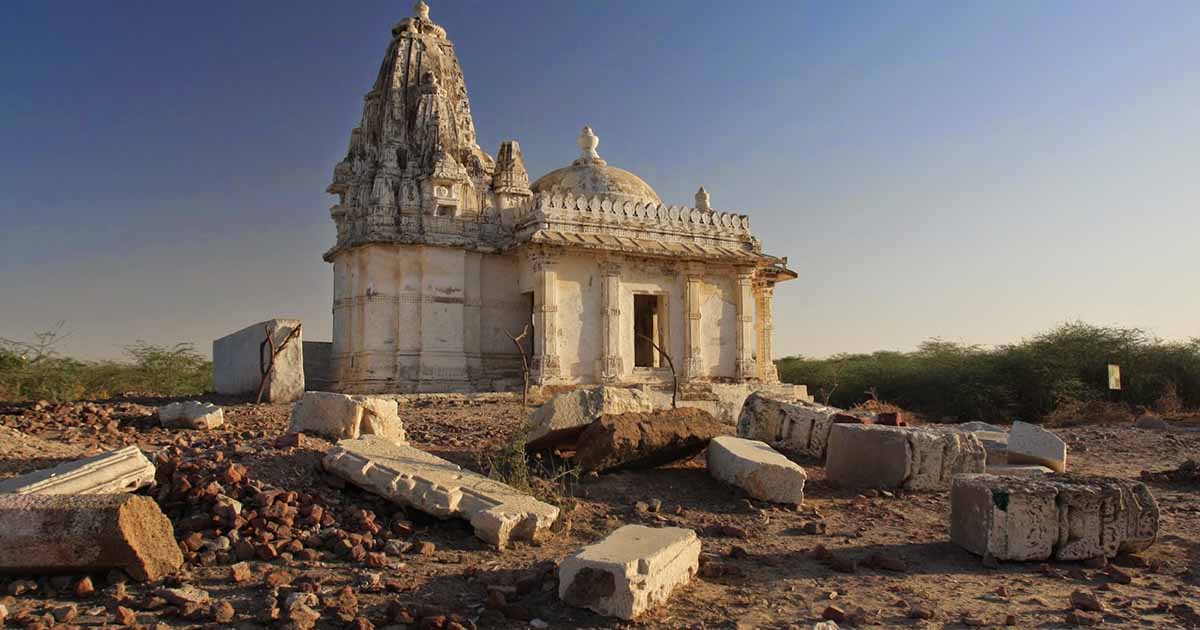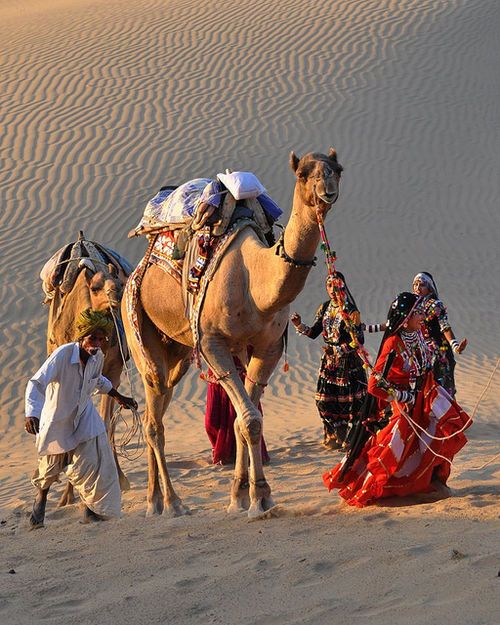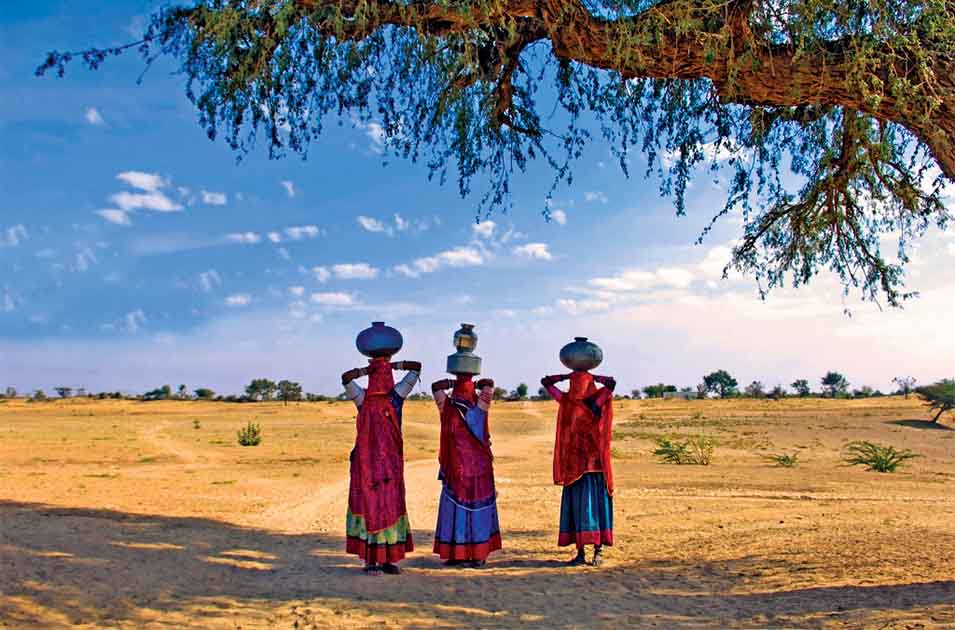Lahore Fort
Lahore Fort is located at an eminence in the northwest corner of the Walled City. The citadel is spread over approximately 50 acres and is trapezoidal in form. Although the origin of this fort goes deep into antiquity, the present fortifications were begun by Mughal Emperor Jalaluddin Muhammad Akbar.
There is evidence that a mud fort was in existence here in 1021, when Mahmud of Ghazni invaded this area. Akbar demolished the old mud fort and constructed most of the modern fort on the old foundations. The fort's mud construction dates back to the early Hindu period. The fort is mentioned in connection with Muhammad Sam's invasions of Lahore in 1180, 1184, and 1186. It was ruined by the Mongols in 1241, and then rebuilt by Balban in 1267.
It was again destroyed by Amir Taimur's army in 1398, to be rebuilt in mud by Sultan Mubarak Shah in 1421, then taken and repaired by Shaikh Ali. The present fort, in brick and solid masonry, was built during Akbar's reign between 1556 and 1605. Every succeeding Mughal emperor, as well as the Sikhs and the British, added a pavilion, palace, or wall to the Lahore Fort, making it the only monument in Pakistan which represents a complete history of Mughal architecture.
There are two huge gates in the fortifications, one each in the middle of the east and the west sides. The western gate, known as Alamgiri Gate, is presently used as the main entrance; however, plans are afoot to open the eastern gate, the Fort's Masjidi Gate, to the general public as well.
The Masjidi Gate, built in 1666 during Akbar's reign, was the original entrance to the fort and faces the historic Maryam Zamani Mosque. Alamgiri Gate, a magnificent double-storey gate, was built by Emperor Mohiuddin Aurangezeb Alamgir in 1673 and faces the grand Badshahi Mosque and opens into Hazuri Bagh. The imposing semicircular bastions flanking the gateway have lotus petals at their base and are highly fluted, crowned with small, graceful domed kiosks. The fortification wall is built of small burnt bricks strengthened with semicircular bastions at regular intervals.
For access to the present entrance, from Circular Road (road encircling the Walled City) you should take a turning south, opposite the famous Minar-e-Pakistan tower dominating the expanse of Iqbal Park or Minar-e-Pakistan Park (formerly Minto Park). The wall that you will notice from the Circular Road is the Sikh Period perimeter wall, beyond which the original Mughal fortification wall is visible. The road leads to Hazuri Bagh and Badshahi Mosque. As you enter the Hazuri Bagh perimeter, you will find the massive Alamgiri Gate on your left side.
Before entering the Hazuri Bagh, if you turn your attention to the Mughal fortification wall, you will be able to enjoy a spectacular tile-mosaic mural wall, extending to nearly 1500 feet and about 55 feet high. This is the famed Pictured Wall of the Great Mughals, of which the Hathi Pol-the lofty Shahjahani Gateway—is an integral part. This gateway allowed the royal entourage on elephants to enter the citadel, traversing the elephant ramp that terminates at the forecourt of Shah Burj.
The Pictured Wall, so labelled by archaeologist Ph. Vogel in his monograph, extends the whole length of the west fortification wall, with belvederes situated in the Shah Burj including the famous Naulakha Pavilion visible from the lower level. The view from below hardly prepares you for the spectacular structures you will find when you enter the Shah Burj quadrangle.
The mural wall turns the corner and continues as the north fortification wall, with several pavilions situated on the top and overlooking the north aspect—this is the area where once the waters of the Ravi washed the foundations of the fortification wall. This is where a promenade with beautifully laid out gardens by the river bank, along with spaces where elephant and other animal fights were held for the amusement of the royal family and the courtiers watching from an eminence.
The Pictured Wall is a spectacular display of Mughal court life and is a remarkable mural, the only one of its kind in the world. where most of the northern wall was rendered in tile mosaic (kashi) during Jahangir's reign, part of the north wall, under Shah Burj and the whole of the west wall is the work of Shah Jahan. Interestingly, the same architect, Abdul Karim Mamur Khan, was employed by Jahangir and during the early part of Shah Jahan's reign, a fact which was instrumental in bringing harmony to the two sections. However, if examined carefully, certain differences can be seen between the walls of the two periods.
The citadel is divided into different sections, each creating its own world within its quadrangle, but they are all interconnected for ease of administration of the fort. In the various sections of the citadel you will be able to enjoy the contribution of successive Mughal emperors—at least three of the Great Mughals are represented within the confines of the citadel, namely Akbar, Jahangir and Shah Jahan. The fourth, Emperor Aurangzeb Alamgir, although he built outside the citadel, constructed the impressive Badshahi Mosque and, like the other three left an indelible architectural mark on the cultural map of Lahore.
Maidan Diwan-e-Aam (Garden of Public Audience) located in the south of the citadel, is the earliest and the most important element of Mughal court ceremonial spaces. Its generous dimensions of 730'x460' providing an arena of enormous scale once framed by a perimeter of cloisters, it allowed the pageantry of the Mughal court to be enacted with extraordinary splendor. The cloisters—numbering 114 according to historian al-Badayuni—and dated to Akbar's period, are no longer extant, their foundations alone defining the garden today.
Much damage was caused during the Sikh occupancy and Inter-Sikh wars, and after annexation many cloisters were demolished to construct European artillery and infantry barracks when the Mughal fort served as a British cantonment. From the garden you can see the British ceremonial steps lining the southern edge, leading down to the road considerably below its ground level. Although intended as a grand entrance to the fort when the Mughal wall was demolished to make way for the grand steps, this entrance is no longer used.
Diwan-e-Aam dominates the centre of the north periphery of the garden and carries the focus of all activity, with the marble Jharoka or throne gallery projecting from its rear wall. The Diwan-e-Aam is constructed on a raised platform bounded by a stone katehra or railing. The hall measures 187 feet by 60 feet and rises to a height of 34 feet. On the second storey, there are beautiful cusped marble arches at the back of the building, looking down to Jahangir’s Quadrangle. During the reigns of Akbar and Jahangir, the Diwan-e-Aam consisted of a triple canopy of velvet to provide protection from the sun while the floor was covered with rich carpets.
However, among the first orders given by Shah Jahan as emperor was the instruction to replace the velvet canopy by a wooden hall. Soon after, however, a sumptuous chihil stun (40-columned hall) was ordered both in Agra and Lahore. While Shah Jahan's Agra Diwan-e-Aam survives, only the Columns and footprint of the one at Lahore are original—the superstructure arches and roof being a British reconstruction.
The takht-jharoka or throne gallery which is located a few feet above the ground and projects into the Diwan-e-Aam is Shahjahani structure, as is the structure in the rear, the Daulat Khana-e-Khass-o-Aam, overlooking the royal residential quad—Jahangir's Quadrangle situated in the north. Today, the takht-jharoka is accessible to all. After climbing a few steps you might like to contemplate the aura of days gone by.
In your imagination you could conjure up the scene of the Great Mughal's court. For it is the Diwan-e-Aam, and its garden that became the stage on which the pomp and grandeur of the Mughal Empire was exhibited. The cloisters were decorated with costly shawls and carpets, each of the grandees competing to outdo the one next door, with the garden itself dotted with silver pavilions of the princes and costly tents of the grandees, lined with velvet, damask and taffetas.
In the Diwan-e-Aam, a portion of the original Mughal floor—brick flooring of 'old Lakhauri brick'—is distinguishable from the remaining floor. The original red stone poly-faceted column shafts, and the multifoil arched bases that had supported the original roof have been re-used in the hypostyle. You will notice a great deal of similarity with those used in Akbari architecture when you visit Jahangir's Quadrangle. The comparatively simple faceted concave capitals that you see here were transformed into elaborate stalactite capitals beautifully rendered with inlay etc. when Shah Jahan's Shah Burj was later built.
Daulat Khana-e-Khass-o-Aam is accessed by following the steps to takht-jharoka. It is a building cleverly placed to provide transition from the highly public area of the Diwan-e-Aam to the private residential apartments of the imperial harem.
The throne jharoka, overlooking the Diwan-e-Aam in the south, is set above the human height to ensure an elevated position for the emperor. 8'6" in length and projecting 4' from the wall, the elegant and regal jharoka, with its railing of delicate sang-i-murmur (white marble) is roofed over with an elegant sloping chajja and saddle-backed dome. The 4' wide galleries on the two sides of the jharoka, seem to have extended the whole length of the Daulat Khana, acting as a viewing gallery for court proceedings by the imperial female entourage, no doubt seated behind screens.
The building dated to the Shahjahani period was much mutilated during later rules. Consisting of a core of vaulted chambers—the central one an elongated octagon opening into an open-fronted aiwan—the Daulat Khana is bordered by an arcaded verandah circumambulating its three sides. It is a largely arcuate structure sporting, from a simple coved roof, shallow domes on squinches in verandah bays to more complex vaults. From the first floor of the building you can enjoy the freshness of the quad on the north, a chahar bagh bounded by royal pavilions— the zenana of Emperor Akbar. Originally there may have been an access staircase to descend into the quad.
However, it is no longer extant. Few of the original decorative elements in the building are now extant—indiscriminate Sikh over-painting and British 'military whitewash' having camouflaged most of the Mughal evidence. There is little doubt that at one time all surfaces were profusely ornamented. In spite of the loss of surface decoration, evidence of the sumptuous rendering of structure and surfaces can still be seen. On the north verandah, there are two sets of beautifully sculpted seh-dara (3-bay) ensembles consisting of a combination of white marble double-column shafts, and grey-black stone base and ornamental brackets. They are original Shahjahani elements, as are the marble dadoes (izara) with courtly inlay borders of double black lines and of multi-colored inlaid zigzag (chevron) design.
Makatib Khana is located in the northwest corner of the Maidan Diwan-e-Aam. Since there is no access to any quadrangles from the Daulat Khana-e-Khass-o-Aam, you will need to climb down the royal throne steps to return to the Diwan-e-Aam. Makatib Khana is the only inscribed Jahangiri building (1027/1617-18) in the fort, and is well worth a careful examination. It was designed by one of the most accomplished Mughal architects—Abdul Karim titled Mamur Khan, a favourite of both Jahangir and Shah Jahan. Placed ingeniously, this introverted building on the one hand faces the highly public garden (Maidan-e-Diwan-e-Aam) to the east, and on the other provides access to the select quad-precinct of the Moti Mosque located to the north, an area also accessible from several royal apartments located in the northern belt of the citadel.
The eastern facade, with its low level arcade, no doubt designed to relate to the height of extinct cloisters bordering the maidan, carries a tall aiwan (portal) in its centre. The inscription above the portal, while ascribing the building's construction to 1027/1617-18, "the twelfth year of Jahangir's accession by the devoted servant Mamur Khan," describes it as "the building of this daulat khana". This structure is conjectured to be part of a group of royal mansions on which the princely sum of seven lakhs Rupees was expended, and which were much acclaimed by Emperor Jahangir in his delightful memoirs.
The east arcade facing the maidan incorporates raised platforms likely to have been used as sitting places—indicating their use for news writers, mentioned by the traveler Montserrat as noting down the daily court events. As you step down into 62 ' square internal courtyard, you will find it framed by low-height arcade-like bays on all four sides.
The centers of two of these are accented by tall arched recesses and the remaining two by gateways, providing access to east and north mentioned earlier. The arcaded bays employ single-storey, wide pointed arches and accommodate platforms a couple of feet above the courtyard floor, possibly also for the use of scribes. You will find no trace of stone, since Mamur Khan selected the common brick as his basic building material, which once treated with chunam, a polished lime plaster, lent itself to a remarkable array of surface decoration.
However, today little of the once dazzling decoration employed as an integral part of the architectural countenance is in evidence. However, a few decorative fragments of colorful fresco based on floral and vegetal themes can still be seen—some in the aiwan ceiling and mucfarnas (stalactite squinches) as well as some in the courtyard alcoves. Makatib Khana leads directly into the Moti Mosque Quadrangle and to the celebrated sang-e-murmur (marble) Moti Masjid, or the Pearl Mosque.
Haveli of Mai Jindan dominates the eastern periphery of the Moti Mosque Quadrangle. Mai Jindan, (Chandan or Chand Kaur), was the mother of the infant Sikh ruler, Dulip Singh. This two-storey building may have originally been a Mughal structure, however, it is considered a Sikh structure due to large-scale additions by the Sikhs. The building now houses a collection known as the Princess Bamba Collection. This is the building where according to Fakir Qamruddin, during the Sikh War of succession the gruesome murder of Rani Jindan took place.
Jahangir's Quadrangle was begun by Akbar and completed by Jahangir in 1618 and contains some of the earliest Mughal structures in the fort. The area is part of a belt of quadrangles and suites lining the northern periphery above the Mughal fortification wall, and was dedicated to strictly imperial usage. Jahangir's Quadrangle, a quad consisting of royal apartments and a harem sera, was placed in a secure corner of the citadel to ensure the safety and security of the zenana. Also, since the river Ravi once flowed at the foot of the north fortification, the view from the royal quads, overlooking the vast countryside beyond, would have been spectacular.
Most of the buildings around this quad are built upon subterranean chambers, particularly those bordering the quad's northern, eastern and western peripheries. From recent studies, it can be inferred that the east and west suites were built at the same time as the subterranean chambers below them, pointing to Akbar as the architect of the imperial chambers.
The iwans represent the best of Akbari architecture in the region that is now Pakistan. In fact in the rendering of the sculpted imagery in the struts, they surpass the elements found anywhere else in the subcontinent. While there are many elements that are evocative of those employed in Agra or Fatehpur Sikri, there is little doubt that as the last capital built by Akbar, Lahore represents the high point of Akbari architecture in view of the experience gained by Akbari architects and crafts persons while building the earlier capitals.
Jahangir's Quadrangle, 372' x 245' in size, is the largest of all quads, except the Maidan Diwan-e-Aam. In the rectangular quadrangle is set a chahar bagh (paradisiacal garden) with parterres and walkways, cooled by an enormous hauz (tank) and an array of fountains. The central chabutra (mahtabi) or platform, accessed by narrow causeways provides a delightful seat elevated above the water reservoir to enjoy the amiable surroundings. A wonderful fairy tale scene setting decorated with oil lamps (diyas) and candles, was witnessed as late as 1843 by the Prussian Von Orlich when he visited the Sikh durbar.
During the British period the suites in the quad were converted into officers' accommodation, and greatly altered with additions made to cater to military requirements. At the time, the vast space of the original roya 1 quad was utilized to build several new structures consisting of 'cook rooms' and school rooms.
Haveli of Kharak Singh, the heir to Ranjit Singh, occupies the southeast corner of Jahangir's Quadrangle. No doubt it was due to its having been utilized by the heir to the Sikh throne that after the British occupation the first floor was considered suitable for the 'Commandant's Quarters', while the ground floor was used as 'godown and servants' house.
The first floor is presently used by the Archaeological Survey offices and ground floor accommodates the Archaeological Library, a remarkable storehouse of antiquarian books. If you have time, it is worth entering the library, since you are allowed to browse through the collection. The whole southern periphery of the quad would also have been lined with suites similar to the porticoes lining the eastern and western edges of the quad. Today, the surviving red stone seh-dara alone provides the clue to the ancient lineage of the structure.
Mashriqi and Maghribi Iwans (East and West Chambers), built by Akbar, define the quad's eastern and western borders. These symmetrically arranged chambers are the most spectacular of the quad buildings. Originally lined with five iwans or suites on each side, each unit is identified by original distinctive features—the red sandstone seh-dara (three-doorway unit) dalan porticoes. The seh-daras carry exquisitely carved columns and the roof chajja is supported by striking sculpted struts composed of the much-acclaimed figures of elephants, griffins and peacocks. Although the seh-dara is a trabeated structure—using beams and struts of stone—the rooms themselves demonstrate arcuate construction techniques in red Lahori brick which were utilized with great effect to produce lofty vaulted spaces and arched apertures.
Some rooms show simple fresco decoration, though in view of the damage inflicted upon these chambers by various rulers, including present-day custodians, it is difficult to distinguish and identify the original elements.
Mashriqi and Maghribi Suites are identical two-storey, detached graceful mansions located at the northeast and northwest corners of Jahangir's Quadrangle. They are of greater height and the east and west chambers and carry greater refinement in the execution of architectural elements. Although they are placed in continuity of the remaining iwans on either side, from their unique character and elaborate ornamentation of structural elements, it is evident that these mansions were reserved for the more illustrious members of the royal household—the queen mother or a favourite empress—or a favourite daughter such as Shah Jahan's eldest Jahan Ara Begam. Surely these mansions were the place where edicts would have been brought to be stamped with the royal seal, which was always in the custody of the most powerful royal lady of the day.
These mansions provide a delightful opportunity, to experience the most exquisite carving of the Akbari period. The polyfaceted, double-storey columns on multifoil bases of the deep set portico, and the moulded and carved brackets supporting the soffit of the deep sloping chajja (overhang or projection), are all incised with a delicate overall pattern. The most stunning of all are the flamboyant, 2-stage highly figurative struts, based on animal imagery, to support the deep eaves.
In each of the mansions, flanking the seh-dara are two projecting semi-octagonal balconies, with their bases elaborately fashioned out of innovative brick corbelling. Faint traces on the muqarnas of these provide evidence of the once highly decorative, embellished and gilded fresco work.
It is worth entering the seh-dara portico of the east suite since you will find an interesting two-level mezzanine arrangement in the portico. From the portico you can view the vaulted rear chambers, and gauge the splendour and loftiness of the accommodation.
Khwabgah-e-Kalan (Bari Khwabgah) is a detached single-storey arcaded palace building located in the centre of the chahar bagh overlooking the north aspect of the fort. Through its rear openings could once be viewed the verdant surroundings bordering the river Ravi. Today, the Ravi, having receded, is no longer visible, while the Bari Khwabgah (Great Chamber of Dreams) is a much disfigured version of the original building attributed to Jahangir.
In view of the evidence of historical sources regarding Jahangir's habit of rebuilding on the foundations of buildings constructed by his father, Emperor Akbar, the Jahangiri palace itself is likely to have been built upon the walls of an earlier palace or khwabgah, below which lie the subterranean chambers attributed to Akbar.
The current building presents a 19th century remodelled veranda in the front, while the 3-chamber arrangement in the rear with thick walls, vaults and squinches is indicative of original construction. During the British occupation of the fort, new constructions totally camouflaged the original structure and for a time, the building was thought to have been constructed by the Sikhs. However, after the removal of various additions, the building was taken in hand and was 'restored'. The pointed arches as part of the reconstruction effort were believed by the 'restorers' to be Jahangiri architectural expression, but really have no affinity with Jahangiri architecture.
You may not be able to view the interior of the building, since it is utilized as a museum and is open during fixed hours only. However, it is worth timing your visit to the fort so that you are able to view the collection. The interior is also worth a visit to examine the original arcuate construction of the chambers, in which evidence of fresco work on qalib kari (stalactites) can also be seen.













